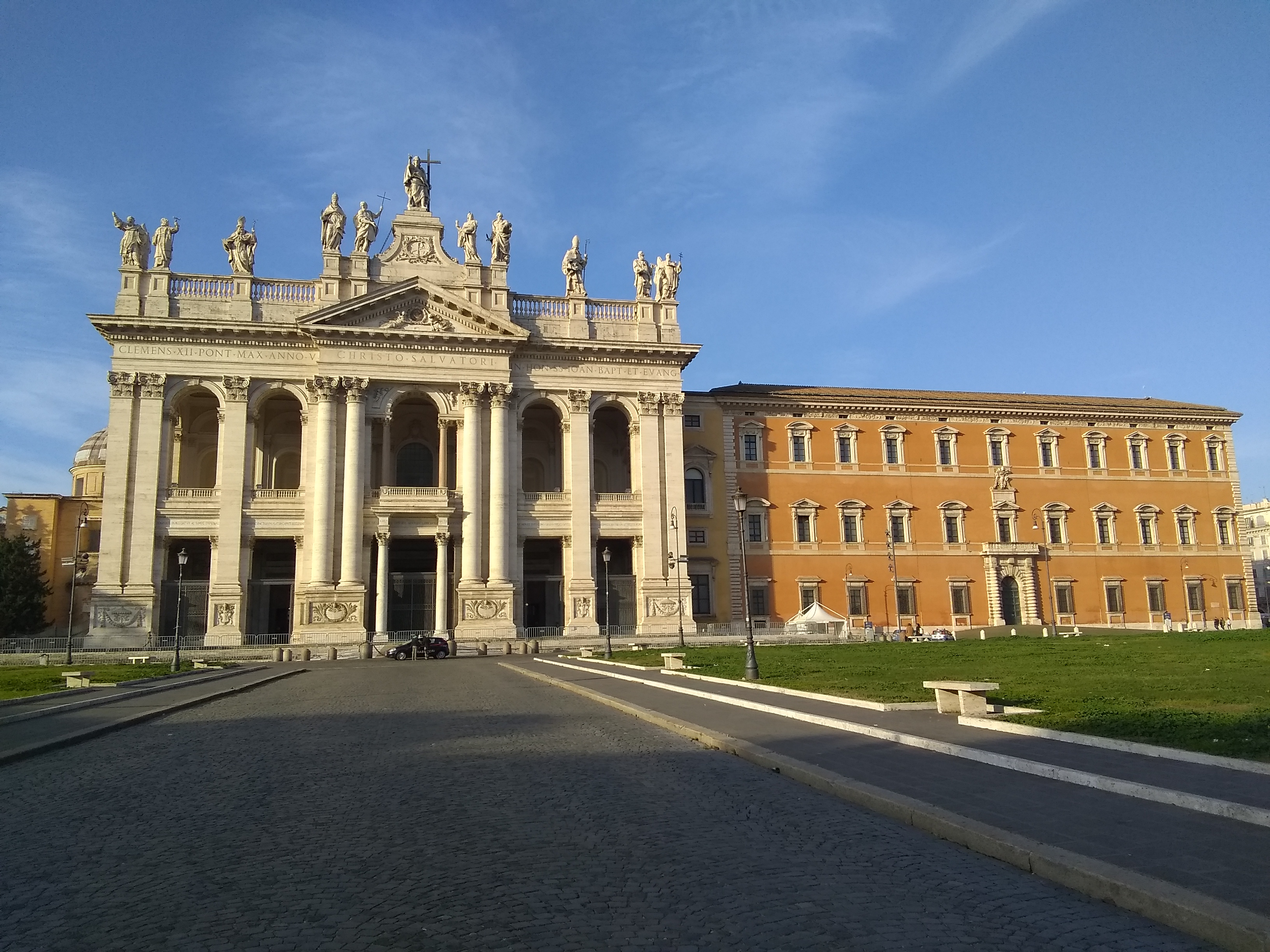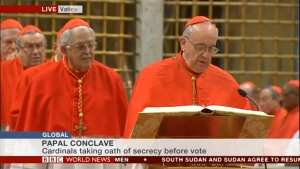This week, Catholic Family News, the traditional private Catholic Newspaper founded by the late John Vennari, publishes an article entitled, “Socci’s Thesis Falls Short: Review of the Secret of Benedict XVI“, an English translation of an article which was published on Jan 8, 2019 online at Cooperatores Veritatis. The translator is a Giuseppe Pelligrino. (Socci’s book details facts and canonical arguments why Pope Benedict XVI is still the Pope, and Bergoglio an Anti-Pope, that is uncanonically elected). I will comment on the English version of the article.
The author, Dr. Roberto de Mattei, I have long admired, and have had the occasion to meet in person. His foundation, the Lepanto Foundation does much good work, and thus I bear him no animus. Nay, if the author of that article was someone unknown or not influential at Rome, I would probably have paid it no attention at all.
Moreover, the purpose of this present article is not to defend Socci’s book. Rather it is to address the grave errors contained in De Mattei’s article, which on account of his personal reputation are magnified in the minds of many, and thus represent a danger to souls.
Here, then, I will discuss the errors briefly in the order they appear in that English translation by Signor Pellegrino.
The first error of which is that De Mattei sustains that the resignation of Pope Benedict XVI is valid, because there has been a peaceful and universal acceptance of the election of Jorge Mario Bergoglio.
I will put aside the fact that several recent polls (not scientific) have shown that as much as 70% of Catholics reject Bergoglio as pope, because there is a more serious error to address, than disputing whether there is in fact a peaceful and universal acceptance of Bergoglio’s election.
Signor De Mattei is learned enough to own a copy of the Code of Canon Law. So I humbly suggest he read Canon 359 and consider publicly withdrawing his assertion that a peaceful and universal acceptance of an apparent papal election establishes it to be held as valid by Catholics. For, that canon reads in Latin:
Can. 359 — Sede Apostolica vacante, Cardinalium Collegium ea tantum in Ecclesia gaudet potestate, quae in peculiari lege eidem tribuitur.
When translated into English — here I give my own translation — that canon says:
Canon 359 — When the Apostolic See is vacant, the College of Cardinals only enjoys that power in the Church, which is granted to it in particular law.
This is the reference to the power of the College to elect the Pope. So, according to Canon 359, when there is no pope, the Cardinals have the authority to elect a pope.
Now, if the resignation of a pope is in doubt, then obviously, there is a doubt whether the Apostolic See is vacant, and therefore the Cardinals have doubtful authority. And when a resignation of a pope has not taken place, or a pope is not dead, the Apostolic See is not vacant, and therefore the Cardinals have NO power to elect another.
So, it should be obvious then, that “the peaceful and universal acceptance of the election of a pope by a College of Cardinals” which HAS NO POWER to elect a pope, because the See is NOT vacant, DOES NOT MAKE THE ELECTION VALID.
Second, De Mattei claims this principal regarding the acceptance of the election of a pope on the basis of commonly held opinion. But if he has studied Canon Law, he should know that Canon 17 does not permit common theological or canonical opinions to be interpretative guides to reading any canon, when the text of the canon expressly forbids an act to take place by denying the body which acts the power to act. For in such a case the mind of the Legislator takes precedence.
Third, what is worse, De Mattei then cites the Vatican translation of Canon 332 §2, where he admits that it denies that a papal resignation is valid on the grounds that anyone accepts it (in its final condition)! How that squares with the theory of peaceful and universal acceptance is impossible to imagine, since it undermines the validity of its application to the case of a disputed resignation. It does so, because obviously a Conclave called during the life of a pope who has not resigned, is called either because that College knows he has not and does intend to elect an Anti-Pope, and then it does not matter who accepts him, his election is invalid; or in the case the College opines that a resignation is valid, and they proceed to act as if there is no pope. But as canon 332 §2 declares, that they think it is valid, does not make it valid. Therefore, even if they think it is valid, when it is not valid, they cannot appeal to Canon 332 §2 to claim the authority in Canon 359 to lawfully elect another. Rather, they must follow Canon 17 and apply it. And so, whether the subsequent election be accepted or not, in the case of elections which follow papal resignations, the principal cited by De Mattei is improperly cited at best because it pertains to another case.
Finally, De Mattei is, in my opinion, intellectually dishonest, when he says that Violi’s canonical study of Pope Benedict’s act of Feb 11, 2013 contributes to the confusion. Because that study, which is cited in the preface of the Disputed Question, published here in November, is a very scholarly well thought out and precise study without any animus or polemic, which gives great clarity to the canonical signification of that papal act. To say that it causes confusion therefore is not based on Violi’s work, but rather seemingly on a desire to advance his own opinion by insulting a scholar who shows greater knowledge of Canon Law than himself.
As for Archbishop Ganswein’s discourse at the Gregorian University, at first glance it does seem to be confusing. But when you research, as Ann Barnhardt has done, what opinions regarding the mutability of the Papacy were being discussed at Tubingen, when Fr. Joseph Ratzinger was a professor of Theology there, then you would rather say its revealing, not confusing at all.
For those who want to understand the correct canonical argument, why Pope Benedict XVI is the Pope and why Bergoglio was never pope, supported by Canon Law and all the evidence, and put in simple terms, see “How and Why Pope Benedict’s Resignation is invalid by the law itself.”



Lou,
You got the legal presumption wrong.
A renunciation is presumed invalid unless it clearly renounces that which it is supposed to renounce.
Just like a last testament is invalid, unless it clearly says it is leaving something to someone.
For those who know Bellarmine, a doubtful pope is not a pope, it is the application of the same legal concept of interpretation to the opposite circumstances.
All this has to do with the concept of Cessation of power. In law, the cessation of power is not presumed. Thus, the cessation of right is not presumed. Contrariwise, in the election of a man to the papacy, we have the right and the Church is bound by law, not to regard it valid unless it meets all the necessary requirements of validity and or legitimacy.
Thus, a doubtfully resigned pope is still pope.
So, since I have corrected an Italian American in the USA, I guess there is no harm correcting an Italian at Rome, who spent years in Brazil.
So Dr. De Mattei, if I can be so bold — and I will be — though it is contrary to what a Franciscan should so in normal circumstances — but now is not normal. Since the Rule of Saint Francis obliges us to hold fast to Roman Pontiffs canonically elected, I would point out to you by a personal note, that THE INVALIDITY OF THE RENUNCIATION MADE BY POPE BENEDICT
DOES
NOT
NEED
TO
BE
PROVEN!
It does not need to be proven, because according to ius testimentarie, that is the genus of right which regards testaments, THE INVALIDLY IS PRESUMED unless it is proven otherwise by a clear and certain statement!
For the Record, Mr. Verrecchio holds that the Renunciation is invalid, as a conclusion. Dr. de Mattei holds that it is valid as a presumption. Each is a different error, and Verrecchio is a better thinker, in my judgement. But until everyone gets the legal principle right, the problem wont be solved.
As I replied again to Louie, in the same post,
Dear Mr. Verrechio,
I did read your comment, you said that you conclude that the resignation is invalid until proven otherwise.
I said, the legal presumption is that a resignation is invalid until proven otherwise.
The point seems to be a fine one, but it is not. A presumption of law is a principle, not a conclusion. It does not exist under certain circumstances and in certain minds or as derived from certain beliefs or not. It exists a priori to all of these on account of the very nature of the legal act.
You do not have to prove it (the invalidity). You do have to accept it (the legal principle), to be a sane rational person…
I could have more easily commented on Dr. de Mattei’s piece by simply saying:
THE INVALIDITY OF THE RESIGNATION HAS BEEN PROVEN!
13 MONTHS AGO!
If you would only read sources which are found outside of the clique of approved outlets you read! >>
VERICATHOLICI.WORDPRESS.COM
And you do not need to take me at my word. Ask any attorney-at-law who practices Estate Law or simply peruse my notes from my meetings with 2 top Canon Lawyers at Rome:
_________
* Just a short note on what happens to a pope who validly resigns. If he was a Cardinal beforehand, he returns to being a Cardinal. This is shown by the statement drawn up by Pope Pius XII in the case of an invasion of the Vatican by Axis forces during World War II. In the case of Pope Celestine V, he returned to being a hermit, because that is what he was before he was the Pope, though he remained a bishop, having been consecrated such after his election (Not all popes were consecrated Bishops). Unless of course, before one resigns, he makes other dispositions, as certainly is within his power to do so. Thus, Pope Benedict, if he really wanted ever to resign validly, could have first established the canonical status he would adopt after resignation, declare his resignation would take place on a certain date, resign on that date, and then assume that status which as Pope he had granted himself as the man who would be soon NOT the pope.
THIS ARTICLE has been published simultaneously in Italian at ChiesaRomna.Info
CREDITS: The featured image is by the author of this article.
+ + +
[simple-payment id=”5295″]